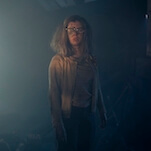Read This: Digging up the origins of the “Indian burial ground” trope

It’s a staple of the horror genre: the doomed house built on an ancient Indian burial ground and now haunted by those whose final resting place has been rudely disturbed. The Indian burial ground trope is seemingly so pervasive in films and television that many viewers may not have even paused momentarily to ponder its origins or motivations. Atlas Obscura’s Dan Nosowitz has, though, and he has collected his findings into a useful little article entitled “Why Every Horror Film Of The 1980s Was Built On ‘Indian Burial Grounds.’” Nosowitz begins his story with something of a bombshell: Poltergeist does not actually contain an Indian burial ground scene, no matter what people may think they remember. The film goes out of its way, in fact, to point out that the cemetery that figures into the plot is “not ancient tribal burial ground.” Instead, Nosowitz alleges, the blame for this trope can be traced to The Amityville Horror, a supposedly factual account that found success as a book in 1977 and a feature film in 1979. No matter that the patently bogus Amityville story is riddled with historical inaccuracies and that the very concept of the “sacred Indian burial ground” is largely a racist myth. The concept echoed throughout films and books of the 1980s, appearing in The Shining and Pet Sematary.









![Rob Reiner's son booked for murder amid homicide investigation [Updated]](https://img.pastemagazine.com/wp-content/avuploads/2025/12/15131025/MixCollage-15-Dec-2025-01-10-PM-9121.jpg)

























![HBO teases new Euphoria, Larry David, and much more in 2026 sizzle reel [Updated]](https://img.pastemagazine.com/wp-content/avuploads/2025/12/12100344/MixCollage-12-Dec-2025-09-56-AM-9137.jpg)




